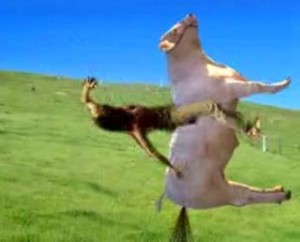Tom Karst of The Packer reports that current food safety guidelines on the proximity of cattle feedlots and leafy greens crops may not be enough to prevent the airborne spread of the E. coli pathogen.
 “Current leafy green field distance guidelines of 120 meters (400 feet) may not be adequate to limit the transmission of E. coli O157:H7 to produce crops planted near concentrated animal feeding operations,” the authors of the study said.
“Current leafy green field distance guidelines of 120 meters (400 feet) may not be adequate to limit the transmission of E. coli O157:H7 to produce crops planted near concentrated animal feeding operations,” the authors of the study said.
The study’s nine authors include researchers from the U.S. Department of Agriculture’s U.S. Meat Animal Research Center, Clay Center, Neb., the University of California-Davis, and the USDA’s Beltsville Agricultural Research Center, Beltsville, Md.
Trevor Suslow, plant pathologist with the University of California-Davis and one of the authors of the study, said the research indicates that proximity to large concentrated animal operations calls for extra diligence in determining risk and in putting in place processes that monitor potential contamination.
FDA produce safety regulations do not specify setback distances between leafy greens fields and cattle feedlots, although the Leafy Greens Marketing Agreement in California, followed by many other organizations, put the number at 400 feet, he said.
“Many times 400 feet is more than enough separation based on position relative to prevailing winds and other times it can clearly result in contamination,” he said. “It is not a simple formula to say everything has to be a mile between feedlot operations. That could make production very difficult in most places,” he said.
Suslow said another part of the study, not published yet, looks at the role of certain types of flies that can carry bacteria from feedlot operations to fields.
Effect of proximity to a cattle feedlot on Escherichia coli O157:H7 contamination of leafy greens and evaluation of the potential for airborne transmission
Appl. Environ. Microbiol. February 2015 vol. 81 no. 3 1101-1110
Elaine D. Berry, James E. Wells, James L. Bono, Bryan L. Woodbury, Norasak Kalchayanand, Keri N. Norman, Trevor V. Suslow, Gabriela López-Velasco and Patricia D. Millner
http://aem.asm.org/content/81/3/1101.long
Abstract
The impact of proximity to a beef cattle feedlot on Escherichia coli O157:H7 contamination of leafy greens was examined. In each of 2 years, leafy greens were planted in nine plots located 60, 120, and 180 m from a cattle feedlot (3 plots at each distance).
Leafy greens (270) and feedlot manure samples (100) were collected six different times from June to September in each year. Both E. coli O157:H7 and total E. coli bacteria were recovered from leafy greens at all plot distances. E. coli O157:H7 was recovered from 3.5% of leafy green samples per plot at 60 m, which was higher (P < 0.05) than the 1.8% of positive samples per plot at 180 m, indicating a decrease in contamination as distance from the feedlot was increased.
Although E. coli O157:H7 was not recovered from air samples at any distance, total E. coli was recovered from air samples at the feedlot edge and all plot distances, indicating that airborne transport of the pathogen can occur.
Results suggest that risk for airborne transport of E. coli O157:H7 from cattle production is increased when cattle pen surfaces are very dry and when this situation is combined with cattle management or cattle behaviors that generate airborne dust.
Current leafy green field distance guidelines of 120 m (400 feet) may not be adequate to limit the transmission of E. coli O157:H7 to produce crops planted near concentrated animal feeding operations. Additional research is needed to determine safe set-back distances between cattle feedlots and crop production that will reduce fresh produce contamination.
